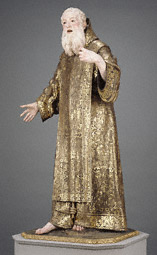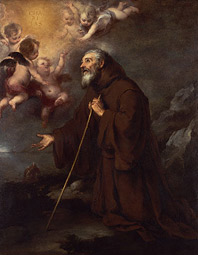|
Luisa Roldán (Spanish, 1652–1706) was one of the most celebrated and prolific sculptors of the 1600s. Affectionately known as La Roldana, she catapulted to fame at the Spanish royal court in an otherwise male-dominated profession. Taking her sculpture Saint Ginés de La Jara as a focal point, this exhibition explores La Roldana's life as well as the multifaceted techniques involved in the sculpture's creation.
The Roldán Family Workshop
Luisa Roldán learned drawing, painting, and sculpture by assisting in the busy workshop of her father, Pedro Roldán (1624–1699), one of the finest sculptors in Seville, Spain. Luisa learned the various techniques for working with clay, wood, stone, terracotta, and ivory, and she probably also mastered the technique of polychroming (adding color to wood). As a young woman, she began to assist her father with increasingly important commissions.
Family artistic workshops such as the Roldáns' were common across 17th century Europe, when art was often produced not by individuals but by workshops that consisted of members of a single family who maintained their practice for generations.
|
 |
|
Artistic Influences
Luisa's father, Pedro Roldán, was a lifelong friend of artists Bartolomé Esteban Murillo and Juan de Valdés Leal. They worked with and consulted one another on various projects and participated in the creation of the first drawing academy in Spain. The three artists and their families, including Luisa, worked for many years on the Santa Caridad project in Seville, which included frescoes, paintings, altars, sculptures, and architectural elements. Luisa created at least some of the figures for the altar of the Hospital de la Santa Caridad, which still exists in Seville.
Murillo was one of Luisa's strongest artistic influences. In this painting he portrayed Saint Francis of Paola kneeling in the midst of a desolate landscape, leaning on a walking stick. Roldana's sculpture of Saint Ginés shares a similar facial expression and gesture; in both works the saints, with eyes and mouths open, are transfixed by a mystical vision.
|
 |
 |
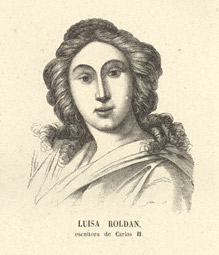
 |
 |
Presumed Portrait of Luisa Roldán, Antonio Rotondo, 1862
|
 |
Independence
At the age of 19, Luisa Roldán left her family home to marry Luis Antonio de los Arcos, an apprentice in her father's workshop. Their romance did not benefit from her parents' blessing, and her father did not attend the ceremony. Luisa and her new husband set up their own independent workshop. Eventually patrons and cities began to contract directly with Luisa, or "La Roldana," clearly the dominant artist. She no longer worked under anyone—she had become an independent artist.
At the age of 36, a very pregnant La Roldana traveled to Madrid to the court of King Charles II (1661–1700) and executed a large figure of Saint Michael. She was appointed escultor de cámara (sculptor to the royal chamber) in 1692. La Roldana's artistic superiority catapulted her to fame at the court. While court sculptor, La Roldana created several life-size wooden polychrome sculptures, including Saint Ginés de La Jara, most likely a royal commission.
La Roldana continued as court sculptor under Philip V until her death on January 19, 1706.
|
 |
|
Saint Ginés de La Jara exemplifies La Roldana's artistic talents. She masterfully worked the hands and feet, sculpting the veins and bones so that they dramatically push against the taut skin. The glass eyes and the painting of the sculpture by her brother-in-law, Tomás de los Arcos, enhance the carving.
|
 |
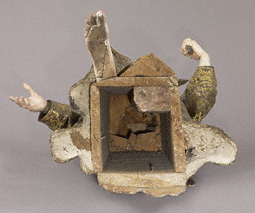
 |
 |
View of Saint Ginés from below, revealing the sculpture's box construction
|
 |
 |
Construction
The first step in the creation of Saint Ginés was the construction of the sculpture's core from two hollow forms—a smaller one on top and a larger box below. Individual boards carved to depict the heavy folds of the robe were glued and nailed to the hollow box.
Once the central structure was assembled, La Roldana shaped the hands, feet, head, and robes from blocks of wood with metal gouges and chisels, then smoothed them with natural abrasives such as dried shark skin and cuttlebone.
The hands were carved separately, then attached with a combination of wooden dowels and nails. The front of the head was made from a separate piece of wood that was carved in place, then removed. The center of the head was hollowed out, allowing glass eyes to be glued in place behind the eyelids. The eyes were probably made in Venice, Italy, as human prostheses.
|
 |
 |
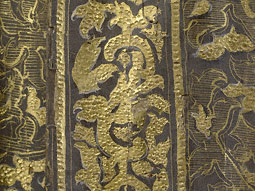
 |
 |
Detail of the estofado on the robe of Saint Ginés
|
 |
Estofado
The sculpture of Saint Ginés was painted by Tomás de los Arcos (Spanish, born 1661), La Roldana's brother-in-law. He created garments that looked like genuine cloth using a technique called estofado, in which one paint layer is scratched through to reveal another layer of contrasting color or material below.
Estofado was used extensively in Spain to depict rich embroidery and brocade on sculptures. The statue's garment was covered in gold leaf and painted over with brown paint, then incised in intricate patterns to reveal the brilliant burnished gold underneath.
|
 |
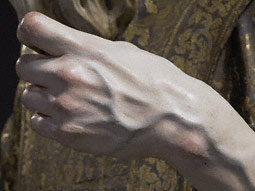
 |
 |
Detail of the left hand of Saint Ginés showing the strikingly lifelike effect created by encarnaciones
|
 |
 |
Encarnaciones
Painter Tomás de los Arcos created the saint's lifelike flesh using a technique called encarnaciones.
After he completed the estofado work on the figure's garments, he added the encarnaciones very thinly to ensure that the fine carving was not obscured. He applied thin layers of glue and gesso, followed by a pinkish beige layer of oil paint for the skin and blue to suggest the veins. He then applied a translucent coat of pinkish beige oil paint over the figure's veins, and added reddish highlights on the knuckles.
The painting of flesh and fabric complements la Roldana's masterful carving, giving the life-size figure of Saint Ginés a physical presence that remains powerful and arresting.
|
 |
|
|
 |
